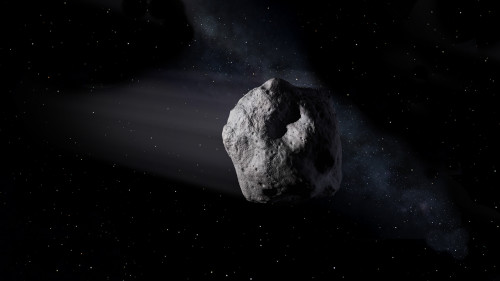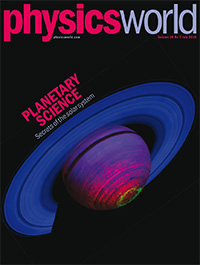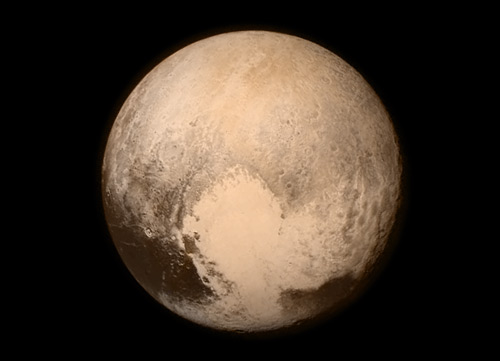Tag archives: planetary science
Grabbing a slice of the pie in the sky

(Courtesy: NASA)
By Margaret Harris at the European Planetary Science Congress in Riga, Latvia
If you wanted to mine an asteroid, what would you need? Right now, it’s a hypothetical question: only a handful of spacecraft have ever visited an asteroid, and fewer still have studied one in detail. As commercial ventures go, it’s not exactly a sure thing. But put that aside for a moment. If you wanted to create an asteroid-mining industry from scratch, how would you do it?
Well, for starters, you’d need to know which asteroids to target. “Not every mountain is a gold mine, and that’s true for asteroids too,” astrophysicist Martin Elvis told audience members at the European Planetary Science Congress (EPSC) yesterday. For every platinum-rich asteroid sending dollar signs into investors’ eyes, Elvis explained there are perhaps 100 commercially useless chunks of carbon whizzing around out there, and the odds for water-rich asteroids aren’t much better. Moreover, some of those valuable asteroids will be impractical to mine, either because of their speed and location or because they’re too small to give a good return on investment. “Smaller asteroids aren’t even worth a billion dollars,” Elvis scoffed. “Who’d get out of bed for that?”
View all posts by this author | View this author's profile
Secrets of the solar system: the July 2016 issue of Physics World is now out
 By Matin Durrani
By Matin Durrani
Members of NASA’s Juno mission are bracing themselves for the final moments of the craft’s five-year-long journey to Jupiter, which will finally reach its quarry just a few days from now (late on 4 July in North America, early morning on 5 July in Europe). There’ll be an anxious, 40-minute period of radio silence as the spinning craft fires its thrusters and slows down enough to be captured by the gas giant’s gravity.
During that time, staff at NASA’s Jet Propulsion Laboratory will be waiting, nervously, for Juno’s instruments to flicker back on and allow data-taking to begin as the craft starts a year-long orbit of the planet.
For the inside story of Juno and what it hopes to achieve, don’t miss the July 2016 special issue of Physics World magazine – now live in the Physics World app for mobile and desktop. You can also read the article here.
Devoted to planetary science, the special issue includes amazing images from NASA’s New Horizons mission to Pluto, an investigation into auroras on planets other than Earth, and an analysis of what we know about Vesta and Ceres – the two largest bodies in the main asteroid belt.
Curiosity findings puzzle Mars rover team
By James Dacey in San Francisco
Rocks rich in silica have been discovered on the surface of Mars, bearing a resemblance to environments on Earth that support microbial life. It’s the latest finding from NASA’s Mars Curiosity rover, presented today in San Francisco at the annual meeting of the American Geophysical Union.
After landing in the Gale crater region of Mars in 2012, NASA’s car-sized rover spent the first couple of years exploring the planes around the elevated region known as Mount Sharp. Since 2014 the rover has started exploring the mountain itself, working its way up from the base.
View all posts by this author | View this author's profile
Solarquest, Pluto and the importance of New Horizons
By Margaret Harris
Last night, in honour of the New Horizons mission to Pluto, I pulled out my copy of Solarquest. This classic board game was a childhood favourite of mine, and it’s basically Monopoly in space: instead of buying properties named after streets in Atlantic City, New Jersey (or London, if you’re British), you buy planets, moons and artificial satellites. Then, when your fellow players land on an object you own, you charge them rent.
Such nostalgia is all well and good, I hear you say, but what’s it got to do with New Horizons or Pluto? Well, Solarquest’s inventors clearly took their science seriously. By board game standards, there’s quite a lot of physics in it. For example, you can’t leave a planet unless you roll a number high enough to overcome its gravitational pull, and its Monopoly-like property deed cards include facts about each planet and moon as well as their prices.
Pluto fly-by: New Horizons sails past cold, distant world

Perfect view: the sharpest image of Pluto to date taken by the New Horizons spacecraft. (Courtesy: NASA)
By Tushna Commissariat
After trundling through our solar system for more than 10 years, NASA’s New Horizons mission made its closest approach to the dwarf planet Pluto earlier today, at 12:49 BST. It was a mere 12,472 km from the planet’s surface – roughly the same distance from New York to Mumbai, India – making it the first-ever space mission to explore a world so far from Earth.
If you want to find out more about the New Horizons mission, read this recent news story by physicsworld.com editor Hamish Johnston. Above is best close-up view of this cold, unexplored world that the spacecraft sent back before its closest approach (when it was still 766,000 km from the surface), revealing in clear detail many of the planet’s surface features, including the “heart” at the bottom.
View all posts by this author | View this author's profile
Uncovering the truth in social media

Truth and lies in the web of social media. (Courtesy: Shutterstock)
By James Dacey
“On 27 August…Mars will look as large as the full Moon.”
This was a sentence from a widely circulated e-mail in 2005, in the lead up to one of the closest encounters between Earth and Mars in recorded history.
That our neighbouring planet could appear as prominent as the Moon is, of course, complete claptrap. Since the “Mars hoax” first appeared in 2003, it has re-emerged several times over the past decade.
The Mars hoax is an example of a “meme”, a piece of content or an idea that is spread virally across Internet networks. These days, memes such as this can spread with increasing speed and reach, thanks to the ever-growing expansion of social-media sites such as Facebook and Twitter.
Now, however, researchers at MODUL University Vienna are setting out on the ambitious task of assessing the truthfulness of information that goes viral on social-media sites. The folks behind the project, called PHEME, say that one of their major aims is to acquire an improved understanding of the types of dubious information that are most likely to spread across networks.
View all posts by this author | View this author's profile

